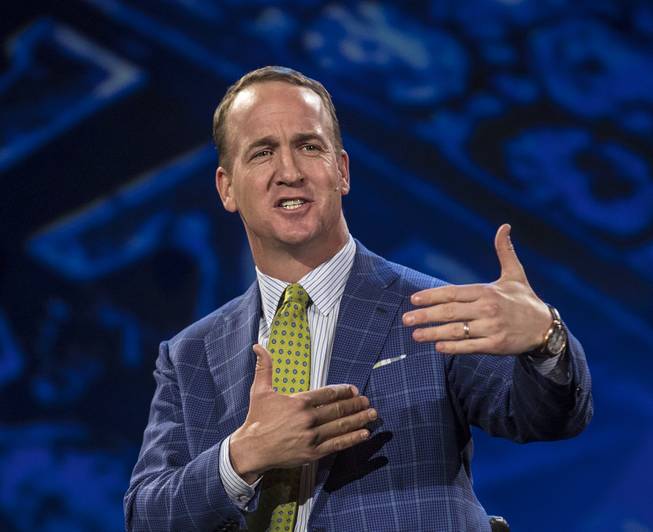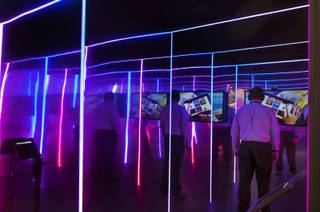
Former NFL quarterback Payton Manning speaks before a large crowd during the Adobe Summit at the Palazzo on Wednesday, March 22, 2017.
Friday, March 24, 2017 | 2 a.m.
A star-studded panel took to the Adobe Summit in the Venetian on Wednesday to speak about the importance of tapping emotion in users’ brand experience.
Addressing a wide range of topics related to tech-user experience and to help launch Adobe’s Experience Cloud, the panel included two-time Super Bowl champion Peyton Manning; Oscar-nominated actor Ryan Gosling; John Mellor, Adobe's vice president of strategic, alliances and marketing; David Fischer, Facebook vice president of business and marketing partnerships; and Pam El, the National Basketball Association's chief marketing officer.
The Experience Cloud is an umbrella product that includes all of Adobe’s analytics, creative and marketing cloud capabilities. Adobe set up what it called the Emotion Chamber at the summit to study the correlation between brand experience and emotional response to various media clips.
“Participants wear wristbands to capture heart rate or skin conductance, and there are cameras that measures facial reaction,” Mellor said. The 30 video clips to stir up different emotions included flying over the Las Vegas Strip and a crying baby being put in the back of a police car. The idea is that a customer will be more likely to use a company or product if they associate them with an emotional experience.
“It’s a pretty incredible roller coaster of emotions over that two-and-a-half minutes,” he said. “It's designed to create some visceral impact.”
The heart rate of some users surpassed 100 beats per minute during their experience, Mellor said. Every displayed experience led to an emotional response from the user.
“When we deal with experiences, we’re dealing with people’s emotions,” Mellor said. “Emotion is the currency of experience.”
Banking on the impact of social media and building up the NBA and the stars that make the league, El touched on the league's push to evoke an emotional connection between the players and the fans.
El elaborated on the vision of NBA Commissioner Adam Silver, who she said recognizes the power of emotionally connecting with fans through storytelling.
Using Q Scores, the measure of the popularity and the marketability of celebrities and athletes, El said the NBA has 20 players that are among the world’s leaders in Q Scores.
“These guys are not only amazing basketball players, but they understand the power of brand. They are very gifted marketers,” she said. “Because of their talents, the game of basketball has never been better.”
The NBA has a massive reach through social media.The league has 32 million Facebook fans, 24 million Twitter followers, 22 million Instagram followers and almost 4 billion views on the NBA’s YouTube page.
Using technology to reach fans is key for the NBA, because El said that less than one percent of fans will actually see a game in person. Through the various social media outlets and mobile apps, the NBA allows fans around the world to view games and highlights at their own pace.
“Our advantage is technology,” El said. “It’s through technology that we interact with most fans on a global basis.”
Virtually anyone now can create their own media buzz from their own home or smartphone. Gosling said he is all for the simplicity despite the industry he’s in.
“Storytelling is always going to be important,” Gosling said. “The really exciting thing for people who are doing it online is that they have control of their product. Final cut is something that maybe 90 percent of editors in Hollywood don’t have, but now anyone with a cellphone and a computer can have it. It’s not to be disregarded, it’s a very powerful thing and it's very exciting. People’s point of view and their true voice can be represented.”
Capitalizing on online video, Facebook sees more 100 million hours of video consumed each day, Fischer said. Although the social media platform is investing in long-form content such as live sports and entertainment, the focus will be on short ads.
Facebook anticipates quick-hit online ads will be more prominent in companies’ marketing plans. Fischer said that there will be less and less emphasis on 30-second television ads.
“Building video for a mobile-first world, which is just making them shorter … Short-form to optimize the screens that we all have in our pockets that’s in our hands all the time,” Fischer said. “We’ve gotten good at working with partners and taking a 30-second spot and editing it down to seven-to-12 second and capturing attention up front.”
With a large amount of Facebook users accessing the site on their mobile device, Fischer said that ads will be optimized for mobile.
The Adobe Summit concluded Thursday with a record 12,000 attendees. The convention is designed for industry leaders, digital marketing and advertising experts to discuss how businesses are transforming their customer service experiences.


Join the Discussion:
Check this out for a full explanation of our conversion to the LiveFyre commenting system and instructions on how to sign up for an account.
Full comments policy